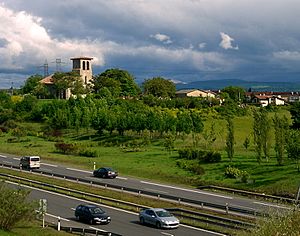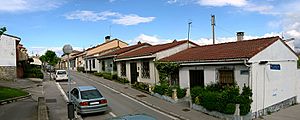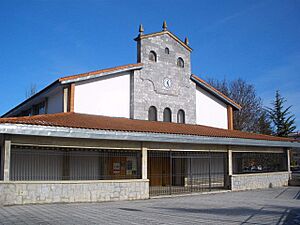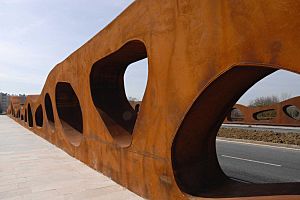Abetxuko facts for kids
Quick facts for kids
Abetxuko
Abechuco
|
|
|---|---|
|
Village
|
|
| Country | |
| Province | Álava |
| Autonomous Community | Basque Country |
| Municipality | Vitoria-Gasteiz |
| Elevation | 524 m (1,719 ft) |
| Population
(2012)
|
|
| • Total | 3,327 |
| Postal code |
01013
|
Abetxuko is a village in the Basque Country, Spain. It's officially called Abetxuku in Basque. You can find it just outside the city of Vitoria-Gasteiz in the Álava province.
Contents
A Look at Abetxuko's Past
Abetxuko has a long history! It was first mentioned in a very old document from 1025. Back then, it was called Avoggoco. Over the years, its name changed a few times. Some old records show it as Abuchucu or Abechuco.
By the 1600s, the name Abechuco became more common. Later, the Royal Academy of the Basque language suggested Abetxuku as the official Basque name. One idea for the village's name means 'place of blueberries' in Basque.
Abetxuko used to be a separate village outside Vitoria. In the 1300s, it officially became part of Vitoria. This happened after a legal disagreement with another group called the Brotherhood of Arriaga. King Alfonso XI decided that Abetxuko and many other villages would belong to Vitoria.
How Abetxuko Grew
For a long time, Abetxuko was a small village. But in the late 1950s, it started to grow a lot. It became one of the biggest towns near Vitoria.
In 1957, the city and a local bank helped build new homes in Abetxuko. These homes were for people moving to Vitoria from other parts of Spain. Many people from Andalusia, León, and Galicia came to live here. By 1966, the population had grown to 2,775 people. In 2012, about 3,327 people lived in Abetxuko.
Modern Abetxuko: Buildings and Changes
Abetxuko was built in two main stages. First, there were single-family houses, some even built by the owners themselves! Later, apartment blocks were added.
Today, Abetxuko is fully connected to the city of Vitoria. A cool new bridge was built, and a tram line arrived in 2009. These changes helped connect Abetxuko even more. New public and private homes have also been built. The "little houses" that were once not so popular are now very much wanted! Abetxuko has really improved over time.
Amazing Monuments to See
Abetxuko has some interesting old buildings and structures.
San Miguel Church
- The original village church is called San Miguel. It's a very old church, built in the 1100s in the Romanesque style.
- It has been fixed up many times since then, in the 1600s and 1900s.
- Inside, you can see a sculpture called Cristo en Cruz (Christ on the Cross). This sculpture came from an old monastery in the Badaya mountains.
- The tall bell tower on the west side is from the 1100s. The side chapels with arches were added in the 1500s.
San José Obrero Parish Church
- This is a newer church, opened in 1961.
- Its architect was Ignacio Lasquiver Urquiola.
- Inside, there's a beautiful statue of the Virgin Mary from the 1700s. It came from a place called Gamboa.
The Zadorra River Bridge
- There's an old stone bridge over the Zadorra River.
- This bridge was built in the 1600s. It's a cool piece of history!
See also
 In Spanish: Abechuco para niños
In Spanish: Abechuco para niños





